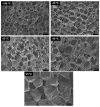A Review on Manufacturing Processes of Biocomposites Based on Poly(α-Esters) and Bioactive Glass Fillers for Bone Regeneration
- PMID: 36810412
- PMCID: PMC9945144
- DOI: 10.3390/biomimetics8010081
A Review on Manufacturing Processes of Biocomposites Based on Poly(α-Esters) and Bioactive Glass Fillers for Bone Regeneration
Abstract
The incorporation of bioactive and biocompatible fillers improve the bone cell adhesion, proliferation and differentiation, thus facilitating new bone tissue formation upon implantation. During these last 20 years, those biocomposites have been explored for making complex geometry devices likes screws or 3D porous scaffolds for the repair of bone defects. This review provides an overview of the current development of manufacturing process with synthetic biodegradable poly(α-ester)s reinforced with bioactive fillers for bone tissue engineering applications. Firstly, the properties of poly(α-ester), bioactive fillers, as well as their composites will be defined. Then, the different works based on these biocomposites will be classified according to their manufacturing process. New processing techniques, particularly additive manufacturing processes, open up a new range of possibilities. These techniques have shown the possibility to customize bone implants for each patient and even create scaffolds with a complex structure similar to bone. At the end of this manuscript, a contextualization exercise will be performed to identify the main issues of process/resorbable biocomposites combination identified in the literature and especially for resorbable load-bearing applications.
Keywords: PLA; bioglass; manufacturing process; mechanical properties.
Conflict of interest statement
The authors declare no conflict of interest.
Figures















Similar articles
-
Additive manufacturing of bioactive and biodegradable porous iron-akermanite composites for bone regeneration.Acta Biomater. 2022 Aug;148:355-373. doi: 10.1016/j.actbio.2022.06.009. Epub 2022 Jun 9. Acta Biomater. 2022. PMID: 35690326
-
Synthetic Biodegradable Aliphatic Polyester Nanocomposites Reinforced with Nanohydroxyapatite and/or Graphene Oxide for Bone Tissue Engineering Applications.Nanomaterials (Basel). 2019 Apr 10;9(4):590. doi: 10.3390/nano9040590. Nanomaterials (Basel). 2019. PMID: 30974820 Free PMC article. Review.
-
Engineering 3D printed bioactive composite scaffolds based on the combination of aliphatic polyester and calcium phosphates for bone tissue regeneration.Mater Sci Eng C Mater Biol Appl. 2021 Mar;122:111928. doi: 10.1016/j.msec.2021.111928. Epub 2021 Feb 3. Mater Sci Eng C Mater Biol Appl. 2021. PMID: 33641921
-
Recent trends in the application of widely used natural and synthetic polymer nanocomposites in bone tissue regeneration.Mater Sci Eng C Mater Biol Appl. 2020 May;110:110698. doi: 10.1016/j.msec.2020.110698. Epub 2020 Jan 29. Mater Sci Eng C Mater Biol Appl. 2020. PMID: 32204012 Free PMC article. Review.
-
3D-Printed PLA-Bioglass Scaffolds with Controllable Calcium Release and MSC Adhesion for Bone Tissue Engineering.Polymers (Basel). 2022 Jun 13;14(12):2389. doi: 10.3390/polym14122389. Polymers (Basel). 2022. PMID: 35745964 Free PMC article.
Cited by
-
Engineering of Bioresorbable Polymers for Tissue Engineering and Drug Delivery Applications.Adv Healthc Mater. 2024 Dec;13(30):e2401674. doi: 10.1002/adhm.202401674. Epub 2024 Sep 4. Adv Healthc Mater. 2024. PMID: 39233521 Free PMC article. Review.
References
-
- Hajiali F., Tajbakhsh S., Shojaei A. Fabrication and Properties of Polycaprolactone Composites Containing Calcium Phosphate-Based Ceramics and Bioactive Glasses in Bone Tissue Engineering: A Review. Polym. Rev. 2018;58:164–207. doi: 10.1080/15583724.2017.1332640. - DOI
Publication types
Grants and funding
LinkOut - more resources
Full Text Sources

